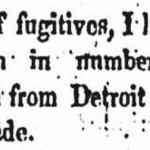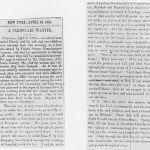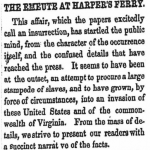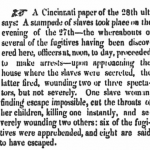
Weekly Anglo-African, October 7, 1859
Search Summary
- Search conducted by Amanda Donoghue on Dec. 20
- Keywords: stampede, exodus, group slave escape, Missouri escape
- Total results: Black Abolitionist Papers (BAP) = 6, Black Abolitionist Archive (BAA) = 1
Results
- “A Cincinnati paper of the 28th ult says: A stampede of slaves took place on the evening of the 27th-the whereabouts of several of the fugitives having been discovered here, officers at noon today proceeded to make arrests-upon approaching the house where the slaves were secreted, the latter fired, wounding two or three spectators, but not severely. One slave woman, finding escape impossible, cut the throats of her children, killing one instantly, and severely wounding two others: six of the fugitives were apprehended, and eight are said to have escaped.” (Editorial, Provincial Freedom, Toronto, February 2, 1856)
- “A number of fugitives, I have been informed-fifteen in number-have just passed through from Detroit into Canada. Quite a stampede.” (Our Detroit Letter,” Weekly Anglo-African, New York, NY, October 7, 1859, Black Abolitionist Papers)
- On Brown’s raid at Harper’s Ferry: “It seems to have been at the outset, an attempt to procure a large stampede of slaves, and to have grown, by force of circumstances, into an invasion of these United States and of the Commonwealth of Virginia.” (“The Emeute at Harper’s Ferry,” Weekly Anglo-African, New York, NY, October 22, 1859, Black Abolitionist Papers)
- “A colored man named Harris, and his wife and two children were arrested here this morning, on a warrant issued by the United States Commissioner Conneau, and sent by special train to Springfield, where they will be examined tomorrow. The man is claimed by Mr. Patterson, of St. Louis County, MO” (“A Carbonari Wanted,” Weekly Anglo-African, New York, NY, April 13, 1861, Black Abolitionist Archive)
- “[In 1843] Our next undertaking was a regular stampede from Maryland. We met at Banning’s Bridge, and mustered seventy strong at starting, but through some misunderstanding the wrong road was taken, and consequently they were tracked, and after a severe encounter, with the loss of three killed and many wounded, they were forced to surrender to superior numbers, who were well armed. When the return caravan passed through Washington a perfect panic prevailed among the slaves; and of the free colored people there were many who left for fear of the threats which were being made against them carried out.” (“Recollections from the Underground Railroad,” The Elevator, San Francisco, CA, September 22, 1865, Black Abolitionist Papers)
- BAP includes excerpts from Martin Delany’s unfinished novel Blake (1859, 1861-62) that includes a reference at the beginning of chapter 30 to slave stampedes: “The absence of Mammy Judy, Daddy Joe, Charles, and little Tony, on the return early Monday morning of Colonel Franks and lady from the country, unmistakably proved the escape of their slaves, and the further proof of the exit of ‘squire Potter’s Andy and Beckwith’s Clara, with the remembrance of the stampede a few months previously, required no further confirmation of the fact, when the neighborhood again was excited to ferment.” [NOTE: Delany serialized Blake at first in the Afro-American Magazine in 1859 –that was the version contained within BAP]
Select Images:
- Weekly Anglo-African, October 7, 1859
- Weekly Anglo African, April 13, 1861
- The Elevator, September 22, 1865
- Weekly Anglo-African, October 22, 1859
- Provincial Freedom, February 2, 1856
General Notes
- Black Abolitionist Papers (BAP) is a subscription Pro-Quest database that is available to Dickinson College students. Black Abolitionist Archive (BAA) is available to the public for free through University of Detroit Mercy [WEB].
- BAP is the larger, more comprehensive collection (over 15,000 items), but BAA director, Roy Finkenbine, was part of the editorial team at BAP, which includes a printed five-volume collection as well as a microfilm series (and now database). BAP includes black abolitionist newspaper editorials, speeches, meeting and convention materials, and selective private correspondence. BAA offers about 800 published speeches and selected newspaper articles.
- Five articles were found using the term “stampede” to refer to the “colonization” movement of free blacks moving to Haiti or Africa to escape the risk of being enslaved or re-enslaved.





